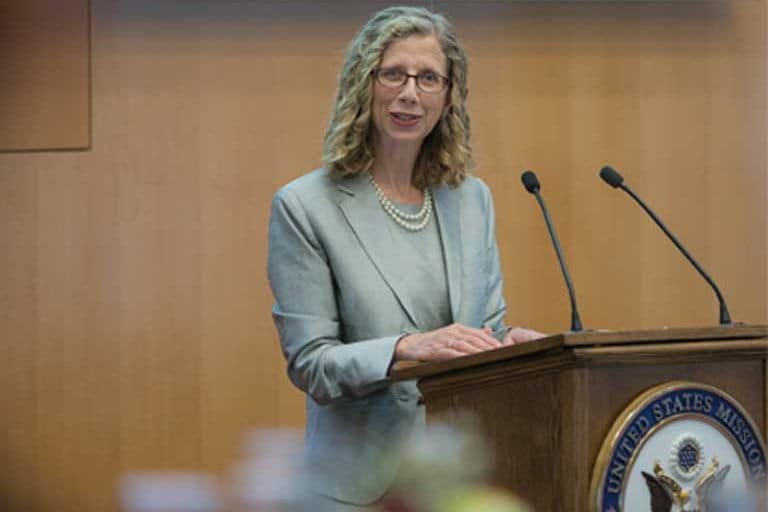by Sean Mowbray on 8 January 2018
- President Donald Trump has proposed cutting foreign aid funding to nations and inter-governmental organizations by 32 percent, about $19 billion – cuts the U.S. Congress has yet to vote on. Voting has been delayed since September, and is next scheduled for 19 January, though another delay may occur.
- One inter-governmental organization on Trump’s cutting block is the International Union for the Conservation of Nature (IUCN) best known for its global Red List, the go-to resource for the status of endangered species planet-wide. Over the past four years the U.S. contributed between 5 and 9 percent of the IUCN’s total framework funding, and 4 to 7 percent of its programmatic funding.
- Currently it remains unclear just how much, or even if, the IUCN budget will be slashed by Congress, leaving the organization in limbo. Another organization potentially looking at major cuts under Trump is TRAFFIC, the international wildlife trade monitoring network.
- Also under Trump’s axe are the UN Population Fund ($79 million), the Green Climate Fund ($2 billion, which no nation has stepped up to replace), and the UN Intergovernmental Panel on Climate Change ($1.96 million annually, funding already replaced by other nations for 2018).

Donald Trump’s 2018 budget remains in limbo – the U.S. Congress has now kicked a budget vote down the road four times, moving it from September 2017, passed two missed December dates, and now to 19 January 2018. And the longer the delays, the more concern there is internationally.
That’s because those final budget numbers aren’t only important to Americans, they are also key to global conservation efforts. In March, the Trump administration laid out proposed draconian foreign aid funding cuts, slashing spending by 32 percent, or around $19 billion. Included were reductions in aid to a raft of nations and inter-governmental organizations with major implications for conservation, women’s rightsand climate change adaptation.
One organization that relies on annual U.S. funding is the International Union for the Conservation of Nature, or IUCN, which celebrates its seventieth anniversary in 2018. The IUCN has long been at the forefront of the conservation movement and is likely best known for its global Red List, the go-to resource for the status of endangered species planet-wide.
“If there were to be significant cuts, for example, to IUCN’s core support… that would be very unfortunate,” says Inger Andersen, IUCN’s director general. Over the past four years the U.S. has contributed between 5 and 9 percent of the organization’s total framework funding, and 4 to 7 percent of its programmatic funding.
It remains unclear exactly how much U.S. funding will be granted to the IUCN, and international conservation efforts in general, in 2018. But, should those U.S. dollars be lost, the potential outcome is largely dependent on how deep and how broad they will be; what is clear is that the loss will be felt by species, ecosystems and societies, says Andersen, who recently spoke to Mongabay about the potential impacts of U.S. environmental policy on her organization and other conservation groups.
One player that could be hit by a reduction in U.S. funds is TRAFFIC, says Andersen. TRAFFIC is the international wildlife trade monitoring network, which tracks illegal trafficking in protected species and their body parts. Set up originally by the IUCN and World Wildlife Fund (WWF), it now operates as an independent entity. How much TRAFFIC’s work will be affected will depend on the severity of funding cuts approved by Congress.

Some organizations have already seen their funding cut and are not waiting on a budget decision. Trump’s decision to quit and defund the United Nations Population Fund (UNFPA), for example, didn’t come as a big surprise to the organization since it supports international family planning efforts, and given that the past three U.S. Republican administrations did likewise, a spokesperson told Mongabay. However, the verdict still hit hard. The U.S has been a major contributor to UNFPA, providing $79 million in 2015 to both the organization’s core budget and specific programs.
“The decision by the U.S. Government was based on UNFPA’s country program in China, which the U.S. did not [even] visit in 2017,” the spokesperson said. “The last time the United States government visited UNFPA’s China Programme, in June of 2015, they provided overwhelmingly positive feedback of UNFPA’s work there, and encouraged UNFPA to continue its work as a force for good.”
The defunding of the UNFPA was “clearly a big loss,” but so far there has been a good response from other donors who could make up the difference, says the spokesperson. “We are confident in our ability to continue saving lives in the short term, but worry more about the longer-term sustainability of increased funding levels from other donors.”


When Trump pulled the U.S. out of the Paris Climate Agreement, he also pulled the funding plug on the Green Climate Fund, as well as the United Nations Intergovernmental Panel on Climate Change (IPCC). Since the IPCC began in 1988, the United States has provided roughly 45 percent of its entire budget which largely goes to scientific assessments of global climate change – reports considered to be the gold standard for forecasting Earth’s global warming future. In 2016, the U.S contributed $1.96 million, which would be wiped out under Trump’s proposed budget. But for the IPCC, at least, a funding crisis in 2018 has abated somewhat, as a number of nations have vowed to plug any gap made by the U.S pulling funding.
Two billion dollars in funding for the Green Climate Fund that Obama pledged – after paying in $1 billion in the last days of his administration – has also been zeroed out by Trump, a serious loss. “No financial institution wants to wake up to the news that it’s lost 20 percent of its pledged funding,” says Stephen Minas, assistant professor of law at Peking University. “That’s not a good day in anybody’s book.” So far no country has stepped forward to plug the Green Climate Fund’s gap.
Conservation, climate and sustainability programs funded through USAID partnerships with developing nations – such as Cambodia, Zimbabwe and Kenya – have also been put at risk by Trump’s 2018 budget. However, many in Congress say that the president’s proposals cut far too deeply into these U.S. State Department programs, and many, like those proposed for Kenya, may not be approved.
Nevertheless, fear and concern about future funding remains. Sophie Mbugua, a freelance journalist based in Nairobi who wrote about the impact of Trump’s cuts in Kenya for Mongabay, faced difficulties getting international organizations to talk on the record. “[A] number of organizations did not want to comment, even individuals did not want to comment… I think there was a fear that they would jeopardize their funding.”
In researching this story, the Green Climate Fund, IPCC and the United Nations Development Programme all declined to discuss U.S. funding on the record.
Some states, like the Pacific island country of Palau “has had to reconfigure its current projects supported by USAID grants, due to reprogramming of funds from the current administration,” Umiich Sengebau, Minister of the Environment for Palau, told Mongabay, adding that despite this, the two countries retain strong ties. Still, his concern is clear: “Diminished funding to climate initiatives will inevitably impact island developing states such as Palau, as it is amongst the most vulnerable of countries to natural disasters and the impacts of climate change.”

Where the axe falls matters
Importantly, say experts, U.S. funding cuts are not occurring in a vacuum – and their full impact depends on where precisely they fall. For example, any potential Trump rollback to IUCN would take place in the context of wider funding issues. For several years now, the IUCN’s unrestricted funds have been declining, falling from $34 million in 2015 to $32 million in 2016, but its restricted funds, earmarked for specific programs, have been rocketing upward and are expected to continue along this trend.
“[Unrestricted] funding, although it’s not large, is quite precious, because you can put it to work, specifically on research or knowledge that is often more difficult to fund,” Andersen explains. Unrestricted funding allows organizations to be much more flexible and agile in carrying out their missions. So far, only one country, Denmark, has pulled its unrestricted funding from the IUCN. The U.S. doing so “would be damaging,” Andersen says, but “we would not allow it to be catastrophic.”
There is also some good news: Despite U.S. budget concerns, the IUCN has had a good year, with increased membership alongside steadily growing public interest in its work. “I would say that there is a much greater understanding of the imperative of conservation,” Andersen says. “The challenge is that we are on a path that sets us on to very unsustainable consumption patterns and therefore we need to accelerate” our efforts.

Making America isolated again
IUCN isn’t only worried by Trump’s budget, but also by the U.S. example. She fears that Trump’s recent dismembering of Bears Ears National Monument and the Grand Staircase-Escalante National Monument could influence other nations to renege on their conservation goals. “We would very much encourage national authorities beyond the U.S. to stay with their targets,” says Andersen.
In her view, the U.S. withdrawal from the international stage, and particularly it’s reigning in of international funding, will ultimately be self-defeating. “On the whole, if you zoom out of IUCN, not having the U.S. as a strong player in development finance and conservation finance, is a loss for the United States.”
By leaving or altering the U.S. relationship with international bodies and individual nations – whether it be by exiting UNESCO or the Paris Agreement, or brow-beating Colombia (where Trump is demanding a return to the drug war and indiscriminate spraying of forests with defoliants) – analysts point out that U.S. is flirting dangerously with becoming an international pariah.
Trump’s foreign policy is “an out-dated, early to mid-twentieth century model, that’s being applied to U.S. leadership in the world now,” says Brian Klass, a political analyst at the London School of Economics, who believes that U.S. global position and stature has diminished under Trump. The last time the United States took a strict isolationist path was in the years prior to World War II, with disastrous results at Pearl Harbor.
Policy experts questioned for this article largely agree that the U.S. risks losing its seat at the international negotiating table – whether that be on trade agreements (such as the Trans-Pacific Partnership, recently concluded without U.S. involvement or benefit), future climate agreements, or military treaties (Trump’s Twitter rhetoric has likely weakened America’s relationship with NATO, according to many policymakers).

For years, Andersen notes, the U.S. has been a “critical voice” and a “crucial funder” within the IUCN, contributing to the organization’s development and, to an extent, its direction. Scaling back involvement would therefore be a “loss for the U.S on the global scale in terms of influence [and] in terms of setting the agenda.”
Still, Andersen remains positive, referencing growing optimism within the conservation movement as a source of inspiration. Her refrain, whether it’s on Trump’s planned cuts to science funding, or reductions to global climate finance, is that elsewhere in the world, the train has left the station, is building a head of steam, and won’t be stopped by one passenger jumping off.
Referencing the U.S. decision to renege on its $2 billion GCF funding along with other climate promises, she says that recent financial pledges at the One Planet conference in Paris are proof that other nations, inter-governmental organization, NGOs and U.S. sub-nationals (states and cities) are ready to step up, putting their money where Trump won’t.
“The truth is that the Green Climate Fund will remain a very strongly supported global priority,” Andersen asserts.
“Lack of action by one party on climate change does not equate to any less action by other parties,” Palau’s Sengebau agrees. He is encouraged by international resistance to Trump and the coming together of U.S. states and municipalities who at the COP23 climate summit in Bonn in November pledged to maintain U.S. emissions reductions, even if the federal government won’t be doing so.
“I would expect that there would come a time when the U.S. will get up to speed with the rest of the world, because climate change is such a reality that it cannot be ignored,” Andersen continues.
She also points out that in many cases, U.S. money is already on the table and is funding initiatives that were started in the past, before the current administration. Projects have a tail, she explains, which can stretch for several years: “Say they were approved a year ago… That tail will continue to disperse and do its good work under the name of the U.S.” despite Trump cutting any future funding.
All agree that significant global conservation and climate challenges remain to be faced – and those challenges could certainly be easier met with U.S. money and know-how – but Andersen is of the opinion that positive momentum is building as the world enters 2018: “Nature is very forgiving and if you invest in nature, it does invest right back in you.”
FEEDBACK: Use this form to send a message to the author of this post. If you want to post a public comment, you can do that at the bottom of the page.
Correction: When published on 8 January this story mistakenly referred to the IUCN as an NGO; it is an inter-governmental organization. The error has been corrected.












Đăng nhận xét